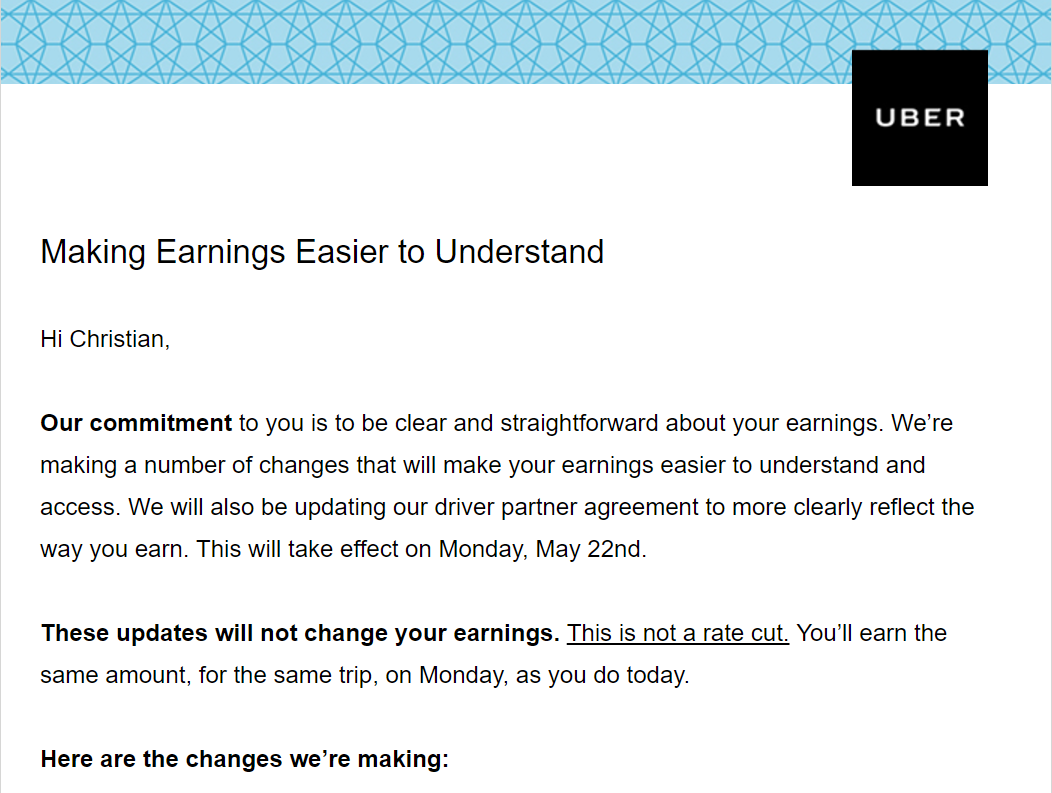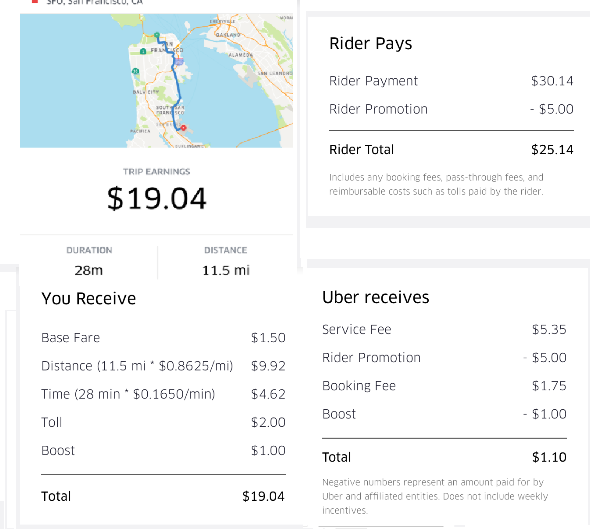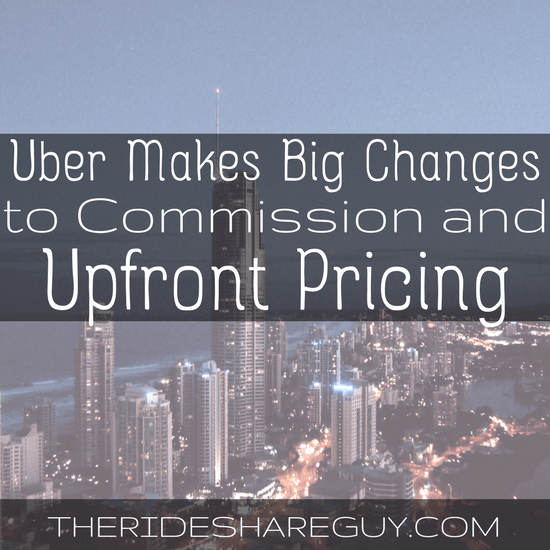Harry here. Uber has announced some pretty big changes recently, so we’re taking a break from our regular scheduled posting to provide you an analysis of these changes. Senior RSG contributor Christian Perea breaks down what you need to know about Uber’s changes to commission and upfront pricing.
Uber announced some pretty big changes to the way they display pay to drivers this week and confirmed that Upfront Pricing will be calculated based off what they think passengers are willing to pay. Uber will now show exactly how much passengers paid for a ride and allow drivers to cash out more earnings on Instant Pay as they drive throughout the week.
The main takeaway for drivers is that Uber will no longer take a 25% commission from fares between riders and drivers in all US cities with UberPOOL. Instead, drivers in these markets will now see their pay reflected “post commission”. It is not a pay-cut; they are now just showing what drivers have already been getting paid after commission all along.
Drivers will still be able to see how much money Uber made from each ride, along with exactly what the passenger paid for that ride as well as any promotions or discounts that were applied. This means that drivers will now get a full financial picture of each fare, which includes how much money exchanged hands among the rider, driver, and Uber.
So although this isn’t a pay cut for drivers, it is a way to increase the commission that Uber gets from every ride.

Upfront Pricing In Uber’s Favor Confirmed
Uber also announced (along with updating your driver contract) that they will now officially determine Upfront Pricing for passengers based on what they think passengers are willing to pay. This means that Uber will use an algorithm to determine different pricing based on a multitude of factors, like which neighborhood they are coming from.
Perhaps most importantly, it means that the pay you receive as a driver is further separated from whatever the passenger pays. According to Uber, rider fares will still be calculated based on time and distance (or at least estimated in a world of upfront fares), and adjustments (up and down) on specific routes in US POOL cities will then calculated on top the estimated time and distance, not apart from it.
An Uber spokesman says that Uber will be doing this to fund driver promotions like Quest and Boost while also using any extra money they take in to become a profitable company. You can check out Eric Newcomers article in Bloomberg for more details on how it will work.
I’m Not Surprised
I’m not that surprised that Uber is doing this though because it is exactly what we thought they might end up doing with Upfront Pricing for the last six months. Harry and I have written multiple articles about how it has been playing out. It’s just official now and, for better or worse, this is the way its going to be.
Previously, Uber had claimed to drivers that they needed to lower fares to be profitable, and drivers would earn more when rates were lower due to increased volume. Uber used that line to justify relentless price-cuts that crippled many drivers’ incomes. Now it seems they are taking a different, contradictory stance.
However, I think prices will rise more for customers in the long term while drivers will receive less “of the cut” unless they jump through hoops like Quest and Boost. Overall, Uber will largely pay drivers the minimum amount needed to keep them driving while collecting as much as they can from passengers in order to widen their margins.
Related Article: The Future of Uber and Lyft Fare Cuts
And don’t worry, Lyft is (probably) going to do it this too to remain competitive. They’ll just wait until Uber takes all the heat for it first 😉
So if you’ve been thinking of driving for Lyft but were on the fence, now may be a good time to sign up before they make changes.
Increased Transparency Around Driver Pay
I’ll give Uber credit where it’s due. They will now be sharing more details around fares with drivers. New fares will reflect the full financial picture of what the passenger paid, what the driver made, and what Uber made or lost on each fare. Here is an example of the new breakdown showing everything in play (minus a $5 airport fee).

Notice how it says the per mileage rate in SF is only $0.8625/mile Instead of $1.15 per mile?
It’s not a pay cut. Pay will be calculated and displayed reflecting what your rates are AFTER Uber’s “take.” For example, the per mile rate in San Francisco is $1.15/mile. After Uber takes 25% it really ends up being $0.8625 per mile. So they are just going to show that instead. So your base, time, distance, surge, etc. will reflect in a way that already accounts for Uber’s commission being taken out.
We Can Now See What The Passenger Paid For Each Ride
In the name of transparency, Uber will actually now provide drivers with a complete picture of the money collected on each ride. The more refined version of a ride receipt will display what the driver earned, what the passenger paid, and what Uber made (or lost) on each ride. It will also display any promotions in play for the individual ride.
I think this is important because it will make it easier to see how much money Uber is making from each ride. This means that if Uber consistently takes more than 25% from our rides, then we can pool our data together in the future to prove that they are charging riders far more than they are paying drivers in the future.
Why The Change In Pay Display?
According to Tom Fellows, a Product Director at Uber:
“Drivers have told us their earnings can sometimes feel like a mystery. That’s why we’re making earnings easier to understand while giving you full transparency into what a rider pays and what Uber makes on every trip. With millions of trips completed every day, there may be outliers in either direction, but you’ll continue to earn based on (base) + time and distance, plus surge and other applicable promotions. We’re hopeful this level of transparency will help bring clarity and build trust in the Uber earnings experience.”
Some Other Changes: Improved Features For Drivers
Better Instant Pay
Uber will now allow for drivers to Instant Pay their earnings in real time for Quest and Boost incentives. So once you earn them within the Uber app, they will be available for Instant Pay. In the past, drivers had to wait until the end of the pay period to collect cash rewarded to them based on such incentives.
Such a move indicates that these programs will be around to stay for a while, even though some drivers have noticed their Quest Pay and Boost incentives seem to vary from week to week in a less predictable manner.
Note: If you’re not eligible for Instant Pay, you can use a service like Active Hours for the occasional instant cash out.
Faster Trip Processing
Uber stated in their email that they will be able to process driver pay for trips faster. In the past, pay was calculated within their system in a step-by-step fashion across millions of trips. This resulted in the system getting backed up as it worked to process through a plethora of trips. The lag time in trip processing was often criticized (by Harry and I) because it prevented drivers and riders from comparing their fares after Upfront Pricing.
What Does It Mean For Drivers?
It’s nice that Uber is being more transparent around what passengers pay for each fare with drivers now. It means we will be able to see in the future how often Uber is taking more than 20% or 25% from our fares. That is good information for drivers and passengers to have.
However, the separation of what passengers pay from what drivers receive in pay is a continuation of Uber trying to widen their margins. Even if we can see how much they are taking from each passenger, it may not mean anything when less of that money comes back to drivers.
The Main Takeaway
While Uber says this is more transparent, they’re also basically confirming that they will be trying to increase their commission as much as possible by paying base rates to drivers and seeing how much they can charge passengers. This makes sense, considering they lost $3 billion in 2016 and they need to figure out ways to shift towards profitability without paying drivers less, since then they wouldn’t have enough supply.
Uber may want us to trust that they will do better with their treatment of drivers via the implementation of a machine learning price machine. However, their history indicates that we should do otherwise. I challenge them to prove our suspicions wrong in the long term.
What do you think of these changes? Do these seem like a big deal to you or is it not really a big deal if you get paid the same as before?
-Christian @ RSG





